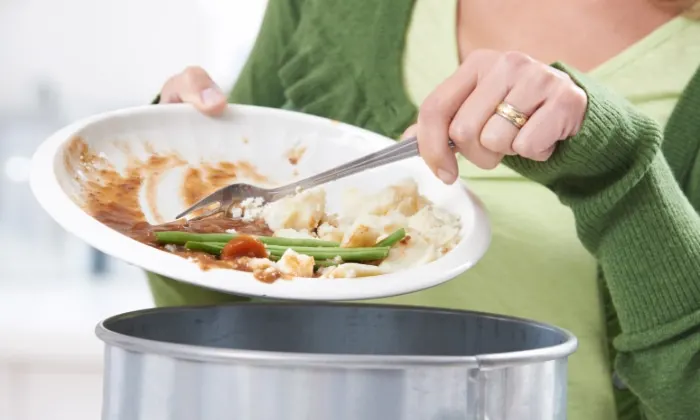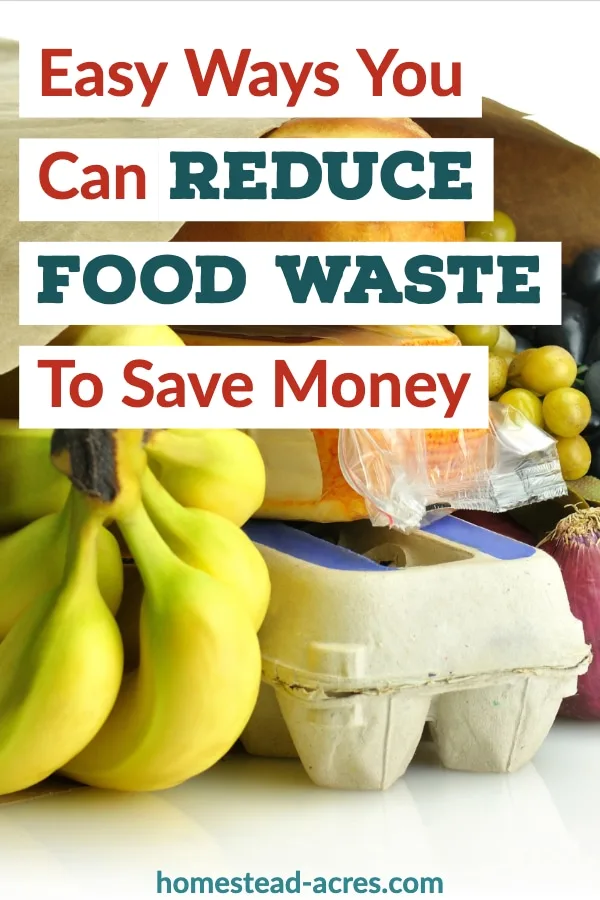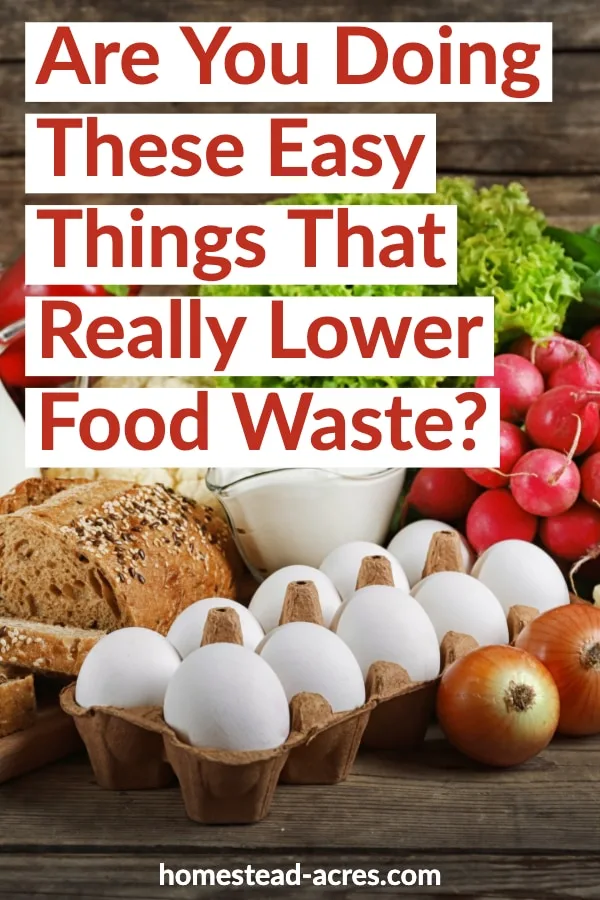This post may contain affiliate links, my full disclosure can be read here. As an Amazon Associate I earn from qualifying purchases.
Wasting food is like throwing your money right into the garbage! The good news is that there are many easy ways to reduce food waste in your home that don’t take much time at all. If you are ready to start reducing your grocery bill then starting with simple food waste solutions is the best way to get started.
Reducing food waste in your home is one of the best things you can do to lower your grocery bill right away.
After all, if you a buying food each week and then throwing it out before it can be used, it’s really like you are tossing money right into the garbage can right?
The sad thing is that on average Americans waste 50% of food and Canadians 63%. That adds up to a lot of money and work for nothing.

But sometimes it can feel overwhelming when you try to start to lower food waste. As moms our lives are busy enough already so adding more to our plate can feel overwhelming.
I remember this all too well it feels like yesterday that I had 5 kids under the age of 6. My days were very, very busy trying to look after everyone and run our homestead too.
But I needed to find ways to cut down on food waste that would help stretch our food budget and work for a busy young family.
You might be feeling that same overwhelmed feeling.
But don’t give up! There are really quick and easy ways you can reduce food waste in your kitchen.
Ways To Reduce Food Waste
1. Shop Wisely

Reducing food waste starts before you even bring your food home. When you go grocery shopping make sure that you are only buying food that your family actually enjoys.
It doesn’t matter if that fancy food is on sale, if your family doesn’t like it, it will go to waste.
Make sure you also don’t overbuy. When you find a great sale it can be tempting to stock up and that’s a good idea.
But stocking up only works when you know how much your family will eat before that good deal goes bad.
2. Start Meal Planning
Starting to meal plan is one of the best ways to save money on food and lower waste at the same time.
Take a little time to plan out what recipes you will make for the next week and then base your grocery list off of that. This way everything you buy you already have a plan for.
3. Store Food Properly
After you bring your food home make sure that you are storing it in the right place.
Keep whole wheat flour in your freezer so it stays nice and fresh. The same goes for any whole grains that have been cracked or ground.
If you store fruits and vegetables in the wrong way it can lead to it going bad faster then it should.
For example tomatoes, cucumbers, garlic, onions, and potatoes should never be stored in your fridge.
Some foods give off ethylene gas as they are ripening whereas some produce is sensitive to this gas and being near it will cause them to spoil faster.
Some foods that give off ethylene gas are:
- Avocados
- Bananas
- Cantaloupes
- Green Onions
- Peaches
- Pears
- Tomatoes
Foods that are sensitive to ethylene gas include:
- Apples
- Berries
- Leafy Greens
- Peppers
- Potatoes
Avoid storing these foods groups near each other.
4. Don’t Over Serve

It can be so tempting to heap that dinner plate full but any mom will tell you that it’s one of the biggest wastes in your kitchen.
How many times do your kids actually eat everything on their plate?
Start with smaller servings and if someone is still hungry they can take a second serving. But it’s better to start with less than to be scraping uneaten food into the garbage later.
If you are worried that smaller servings won’t look as nice on the plate, then try using smaller sized plates.
5. Use Leftovers
Always save leftovers after your meal. Make sure to store them in good airtight containers and label them so you don’t forget what is in there.
Pick a day out of the week that you will use up any leftovers from that week. It’s a great way to save time in the kitchen and money.
6. Keep Your Fridge And Freezer Organized
It can be so easy to lose track of what is stored in your fridge or freezer. So to avoid waste start making sure that you rotate what is in there.
After grocery shopping make sure to bring the older food to the front and the newer food to the back. This will help you to see and use the older food first.
7. Understand Expiration Dates
Nearly all food sold today will have a “sell by”, “best by” or “expires on” date.
“Sell by” is a date for stores to know when they should remove that product from their shelves. Whereas “best by” is a suggested date for buyers to use their food up by.
It doesn’t mean that the day after that food will be no good, it simply means that it will be the freshest before that date.
Most food that is just past its expiration date is just fine. Use common sense when deciding if food a little past the expiration date is safe to eat.
8. Freeze, Dehydrate And Can
There are many ways to preserve extra food before it spoils.
Fruit can easily be frozen, dehydrated or turned into jam. Vegetables are easy to freeze, pickle or can for later use too.
Making refrigerator or freezer jams and pickles is a great way to use up small amounts of fruits and vegetables before they go bad.
9. Make Soup Stock
It’s so easy to make homemade stock and you can use it in a wide range of recipes.
Keep a container in your freezer to add vegetable peelings to. When it’s full enough just pull it out, add water and some seasonings and let it simmer for a while.
You will have turned what would have been wasted into a lovely vegetable stock.
You can do the same with meat bones, just add them to a large pot with vegetables (trimmings are fine), and herbs and let it simmer. Then freeze or can the stock to use later.
10. Make Smoothies
Smoothies are a great way to use up produce.
You can use the tops from carrots, beets and even the ends of broccoli in your smoothies.
Chopped broccoli stalks, vegetable peels, overripe fruit can also be used in smoothie blends and use up produce that would normally have been thrown out
11. Keep Track Of What You Throw Out
Start keeping a list of all the food you are throwing out each week. This will help you start to notice patterns.
If you find you are always tossing out half a loaf of bread then buy or make less bread each week, or freeze half a loaf right away so it stays fresh.
If you find that you just can’t use up leftovers fast enough, freeze them in small portions so you can pull out a single serving later when you need a quick meal.
Keep It Simple
Remember you don’t have to do all of these things at once. Pick one or two things to start doing in your kitchen that will help you cut back on food waste. Once you get used to doing these you can add in another easy step.
What are your favorite tricks for reducing food waste in your home?
Connect With Homestead Acres!
Be sure to follow me on social media, so you never miss a post!
Facebook | Twitter | Pinterest | Twitter
Visit my Amazon store to find all my favorite gardening, homesteading tools, and gadgets plus all of my printed garden books and journals!

Kim Mills is a homeschooling mom of 6 and lives on an urban homestead in Ontario, Canada. Blogging at Homestead Acres she enjoys sharing tips to help you save money, grow and preserve your own food.







